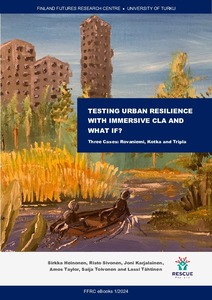TESTING URBAN RESILIENCE WITH IMMERSIVE CLA AND WHAT IF?. Three Cases: Rovaniemi, Kotka and Tripla
Heinonen, Sirkka; Sivonen, Risto; Karjalainen, Joni; Taylor, Amos; Toivonen, Saija; Tähtinen, Lassi (2024-01-12)
TESTING URBAN RESILIENCE WITH IMMERSIVE CLA AND WHAT IF?. Three Cases: Rovaniemi, Kotka and Tripla
Heinonen, Sirkka
Sivonen, Risto
Karjalainen, Joni
Taylor, Amos
Toivonen, Saija
Tähtinen, Lassi
(12.01.2024)
Turun yliopisto. Turun kauppakorkeakoulu
Julkaisun pysyvä osoite on:
https://urn.fi/URN:ISBN:978-952-249-612-6
https://urn.fi/URN:ISBN:978-952-249-612-6
Tiivistelmä
The world is full of volatility, complexity, uncertainty and ambiguity (VUCA), nurturing rapid change and disruption with much potential for crises. Alone in this century, societies have been shaken by multiple crises. Futures studies can help imagining and envisioning sustainable post-crises worlds that are better for all living species. Crises should be counterbalanced by strengthening crisis awareness, crisis preparedness and crisis resilience as is our aim within the RESCUE project (Real Estate and Sustainable Crisis Management in Urban Environments). Testing and rehearsing crises via cognitive, multistakeholder foresight processes helps build futures preparedness and preventive stances. Futures literacy is expanded to embrace crisis awareness and preparedness as a key to robust futures resilience.
Constructing cities worldwide has direct impacts on nature, health, wellbeing and equality. Simultaneously, digitalisation is transforming the urban space profoundly. The sustainable twin transition of the green and the digital requires careful balancing. We should be addressing and modifying the built environment, both land and space, as a rescue mode in crises. Anticipatory governance can drive crisis preparedness and help determine the resilience of urban environments. In this experimental foresight exercise, we apply the metaphor constructing the future in our inquiry on the kinds of governance and regulations that would be needed for making cities and the built environment resilient. What policies would have to be changed; and how should they be framed, for them to become truly transformative? In addition, we look for potential barriers and incentives for promoting successful crisis preparedness, as well as suggestions for concrete policy actions and recommended practices that would promote actor involvement, equal power relations, and collaboration, and as a result enable community empowerment toward resilient urban environments. Methodologically we apply a rehearsing futures approach and use empirical data from three futures cliniques for testing and analysing possible direct and indirect impacts of a crisis. For this exercise the crisis chosen was total electronic blackout and for analysing it we applied the foresight method causal layered analysis (CLA). The data presented in this report was subsequently collected with stakeholders in three different urban cases: 1) Rovaniemi, 2) Kotka and 3) the Tripla complex in Helsinki.
Constructing cities worldwide has direct impacts on nature, health, wellbeing and equality. Simultaneously, digitalisation is transforming the urban space profoundly. The sustainable twin transition of the green and the digital requires careful balancing. We should be addressing and modifying the built environment, both land and space, as a rescue mode in crises. Anticipatory governance can drive crisis preparedness and help determine the resilience of urban environments. In this experimental foresight exercise, we apply the metaphor constructing the future in our inquiry on the kinds of governance and regulations that would be needed for making cities and the built environment resilient. What policies would have to be changed; and how should they be framed, for them to become truly transformative? In addition, we look for potential barriers and incentives for promoting successful crisis preparedness, as well as suggestions for concrete policy actions and recommended practices that would promote actor involvement, equal power relations, and collaboration, and as a result enable community empowerment toward resilient urban environments. Methodologically we apply a rehearsing futures approach and use empirical data from three futures cliniques for testing and analysing possible direct and indirect impacts of a crisis. For this exercise the crisis chosen was total electronic blackout and for analysing it we applied the foresight method causal layered analysis (CLA). The data presented in this report was subsequently collected with stakeholders in three different urban cases: 1) Rovaniemi, 2) Kotka and 3) the Tripla complex in Helsinki.
Kokoelmat
- Erillisteokset ja sarjat [772]
